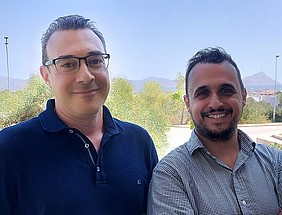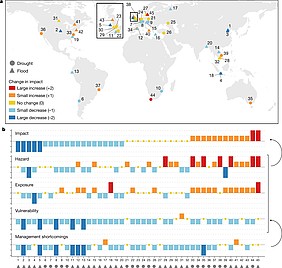A study was recently published in the leading journal Nature (Impact Factor: 49.9) that examines the effectiveness of flood and drought risk management on a global scale with the participation of Associate Professor Aristeidis Koutroulis and Lead Scientist Dr. Manolis Grillakis of the School of Chemical and Environmental Engineering at the Technical University of Crete. The open access publication, titled "The challenge of unprecedented floods and droughts in risk management", is co-authored by 92 scientists and is freely accessible.
Empirical data from floods and droughts that hit the same place twice have shown that risk management alone cannot reduce the effects of extreme events, especially when extreme events are of unprecedented intensity. The authors note that the observed difficulty of managing unprecedented events of high magnitude is alarming, given the higher likelihood of extreme hydrological events due to climate change.
In total, 26 pairs of floods and 19 pairs of droughts that occurred between 1947 and 2019 were analyzed, with each pair occurring in the same region. The two events of each pair were compared in terms of: hazard severity, population exposure (who was at risk), vulnerability (ability to cope with the disaster), risk management strategies in place (such as early warning systems, reservoirs or levees), and the impact (loss of life and economic damage). The extensive documentation and classification of each pair of events resulted in a valuable dataset on changes in the impacts of hydrological extremes over time, available to the scientific community for further analysis.
The main findings of the study are the following:
- Risk management has primarily led to the reduction of the vulnerability from floods and droughts in the past.
- However, the same did not happen in cases where the second event was significantly more severe than the first, exposing the local communities to unprecedented risk. This is probably because existing infrastructure and risk management strategies are not designed for future unprecedented extreme weather events – meaning they are likely to fail despite preventative measures.
- Interestingly there were only two examples in which risk management strategies reduced the impact of a second disaster much more extreme than the first. This resulted from improved governance in risk management and high investment in integrated management. The plan included a set of actions: high investment in infrastructure (new rainwater networks) and other elements such as stricter building regulations, significant improvements in early warning systems and emergency response plans.
- Managing flood and drought risks can sometimes backfire. For example, constructing flood defenses can motivate people to settle in flood-prone areas.
The study concludes on three success factors: (1) effective governance of risk and emergency management, including transboundary partnerships, as in the case of transboundary rivers; (2) high investment in structural and non-structural measures, and (3) improved early warning and real-time monitoring systems. Universal and proactive implementation of these factors will help to reverse the current trend of increasing impacts related to climate change.
















